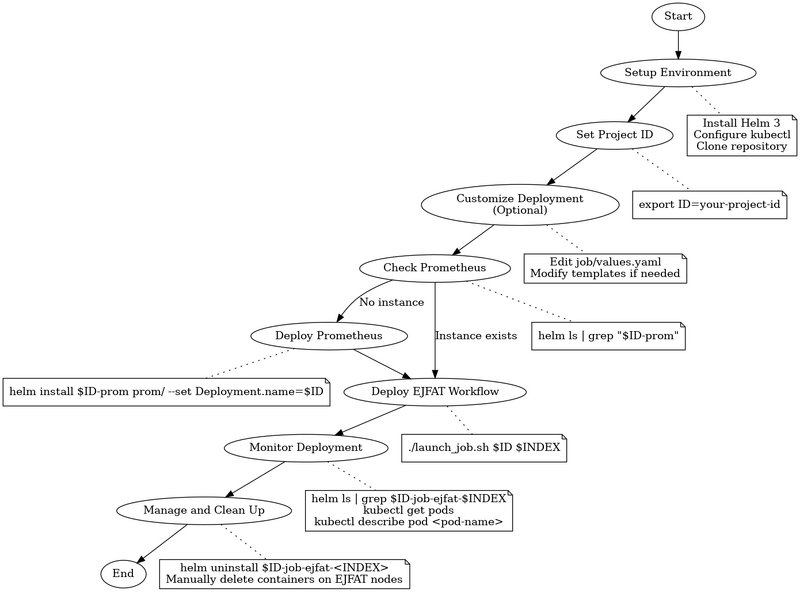Deploy ERSAP data pipelines on EJFAT nodes via JIRIAF
Deploy ERSAP Data Pipelines Workflows on EJFAT Nodes
This guide explains how to use the Helm charts in the main/local-ejfat/job folder to deploy ERSAP data pipeline workflows on EJFAT nodes.
Prerequisites
- Helm 3 installed
- Kubernetes cluster access
- kubectl configured
Chart Structure
The main chart is located in the job/ directory. Key files include:
Chart.yaml: Metadata for the chartvalues.yaml: Default configuration values- Templates in the
templates/directory
Step-by-Step Usage
This diagram provides a visual representation of the steps involved in setting up and deploying ERSAP workflows using the Helm charts in this repository.
1. Setup Environment
- Ensure you have Helm 3 installed, access to a Kubernetes cluster, and kubectl configured.
- Clone the repository and navigate to the
local-ejfatfolder:
git clone https://github.com/JeffersonLab/jiriaf-test-platform.git cd jiriaf-test-platform/main/local-ejfat
2. Set Project ID
- Export your project ID as an environment variable:
export ID=your-project-id # e.g. jlab-100g-nersc-ornl
3. Customize Deployment (Optional)
- Edit
job/values.yamlto customize your deployment. Key settings include:
Deployment: name: this-name-is-changing namespace: default replicas: 1 serviceMonitorLabel: ersap-test4 cpuUsage: "128" ejfatNode: "2" ersapSettings: image: gurjyan/ersap:v0.1 cmd: /ersap/run-pipeline.sh file: /x.ersap
- For more advanced customization, consider modifying the template files in the
job/templates/directory:job-job.yaml: Customize the Kubernetes Job specificationjob-configmap.yaml: Adjust the scripts for job containersjob-service.yaml: Modify the Kubernetes Service configurationprom-servicemonitor.yaml: Fine-tune Prometheus monitoring settings
4. Deploy Prometheus (If not already running)
- Refer to Deploy Prometheus Monitoring with Prometheus Operator or
main/prom/readme.mdfor instructions on how to install and configure Prometheus. - Check if the prometheus instance is running:
helm ls | grep "$ID-prom"
If the command returns no results, it means there's no Prometheus instance for your project ID.
- Install a Prometheus instance for your project if it's not already running:
cd main/prom helm install $ID-prom prom/ --set Deployment.name=$ID
5. Deploy EJFAT Workflow
- Use the
launch_job.shscript to deploy the EJFAT workflow:
cd main/local-ejfat ID=jlab-100g-nersc-ornl INDEX=2 ./launch_job.sh $ID $INDEX
- The script uses the following variables:
ID: The project identifier (e.g., jlab-100g-nersc-ornl)INDEX: A unique index for the job (e.g., 2)
- This script will create two containers on EJFAT node (check
job-configmap.yaml):- jlabtsai/process-exporter:pgid-go
- gurjyan/ersap:v0.1
6. Monitor Deployment
- Check Helm release:
helm ls | grep $ID-job-ejfat-$INDEX - Check pod status:
kubectl get pods - Describe a pod:
kubectl describe pod <pod-name>
7. Manage Deployed Jobs and Clean Up Workflows
- List deployed jobs:
helm ls - Delete a deployed job:
helm uninstall $ID-job-ejfat-<INDEX>
- After uninstalling the Helm release, manually delete containers on EJFAT nodes:
- Log in to each EJFAT node used in your deployment.
- List all containers:
docker ps -a - Identify containers related to your job.
- Remove these containers:
docker rm -f <container-id>
